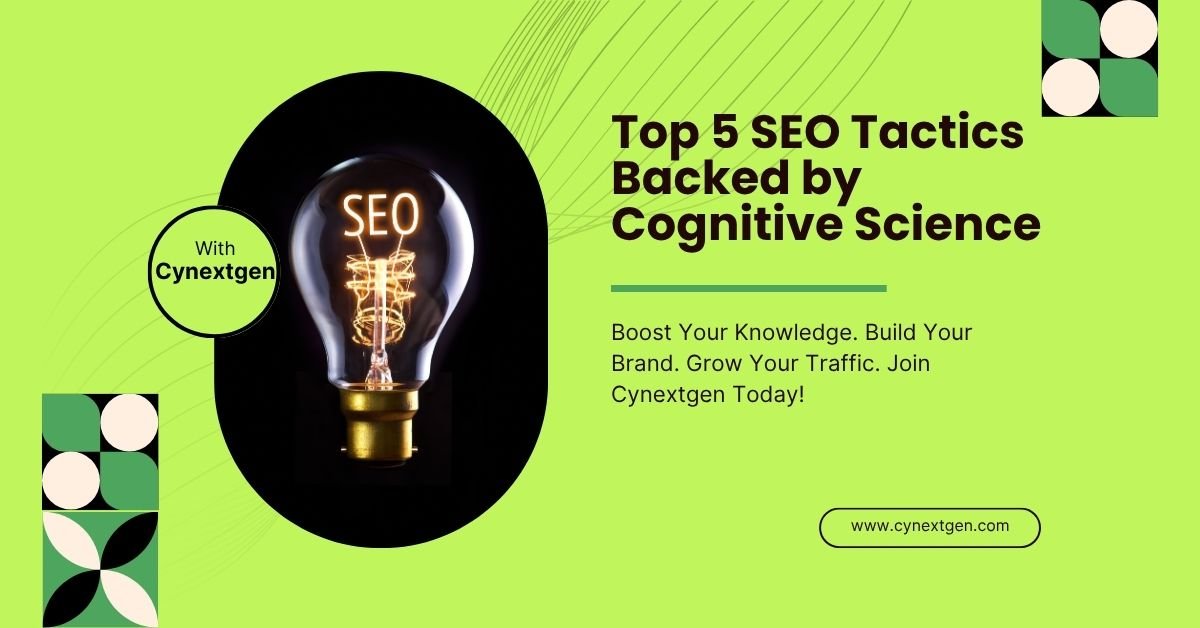
SEO Tactics Cognitive Science: Boost Rankings with Psychology
Search engine optimization (SEO) is no longer just about keywords and backlinks. It’s about understanding the human brain. As search engines like Google become more sophisticated, user behaviour has taken centre stage.
To truly succeed in SEO today, you need to blend science with strategy. That’s where SEO tactics cognitive science comes in. By applying principles from how the brain processes information, you can create content that not only ranks but also resonates.
1. Use Visual Processing to Increase Retention and Engagement
Humans process visual content faster than text, sometimes 60,000 times faster. Cognitive science confirms that our brains are hardwired to respond to visuals. This insight has direct implications for SEO.
Users are more likely to engage with and remember content that includes strong visual elements like images, infographics, charts, or videos. From an SEO standpoint, this improves metrics like dwell time and scroll depth, which signal to search engines that your content is valuable.
For example, adding a relevant infographic can help break up long blocks of text, making your content easier to digest and more shareable. Using visual aids with descriptive alt text also helps improve accessibility and image SEO.
Videos, in particular, keep users on the page longer and can significantly reduce bounce rate. If your blog includes complex topics, a clean, labelled visual can make it more understandable and appealing, enhancing user experience and contributing positively to your SEO performance.
2. Apply the Serial Position Effect to Structure Content
The serial position effect, a concept in cognitive psychology, suggests that people tend to remember the first and last items in a list more than the middle ones. This principle is especially relevant when structuring SEO content.
In long-form blogs or listicles, placing your most important information at the beginning and end can maximize retention. For example, when writing a “Top 10” article, ensure the first and last points are the strongest to leave a lasting impression.
In blog intros and conclusions, reiterate your main idea or message to reinforce learning. Even within body content, placing the most relevant keywords or ideas near the start of a paragraph can help improve comprehension and scanning.
Structuring content based on how users naturally remember information creates a smoother reading experience, which leads to better engagement and higher rankings. It also increases the chances of content being shared or bookmarked.
3. Boost Cognitive Fluency with Clean and Simple Design
Cognitive fluency refers to how easy it is for a person to process information. Content that is easy to read, easy to navigate, and visually apparent is more likely to be trusted, shared, and retained.
In terms of SEO, cognitive fluency improves behavioural signals such as average session duration and click-through rate. When a user lands on your page and finds a wall of text, their brain immediately resists engaging.
But when content is broken into short paragraphs, includes subheadings, and has proper spacing, the brain recognizes it as “easy” and is more willing to engage. Choosing familiar words over jargon, writing in an active voice, and using conversational tones all improve fluency.
From a design perspective, high-contrast colour schemes, legible fonts, and mobile responsiveness are crucial. These elements reduce friction and make your content feel more intuitive. Google tracks how users interact with pages, so if your bounce rate drops and session length increases, you’ll likely see ranking improvements.
4. Use Deep Processing and Dual Coding to Improve Comprehension
According to the Levels of Processing theory in cognitive science, people remember information better when it’s deeply processed. It means that content must be meaningful, organized, and related to the reader’s existing knowledge.
Shallow processing, like keyword stuffing or vague statements, leads to poor retention. To make your content more SEO-friendly and memorable, aim for deeper processing. Explain concepts thoroughly, offer context, and use examples your audience can relate to.
Dual coding theory also supports combining visual and verbal information to reinforce understanding. For instance, if you’re explaining an SEO audit process, don’t just list the steps.
Add visuals like annotated screenshots, flowcharts, or diagrams to help readers visualize the workflow. Use metaphors or analogies that link new ideas to familiar concepts.
It not only helps readers retain information longer but also increases the likelihood that your content earns backlinks, which are still a top-ranking factor in SEO.
5. Use Spaced Repetition and Reinforcement to Build Authority
Cognitive science shows that information repeated over time is more likely to be retained. It is known as the spacing effect. From an SEO perspective, this means repurposing and updating your content regularly.
A single blog post may rank for a while, but reinforcing your authority on a topic requires recurring engagement. You can strengthen ideas by publishing cluster content in multiple posts that target related keywords and link to one another.
This strategy supports both user understanding and SEO. Additionally, re-sharing old content on social media, sending it in newsletters, or creating variations in video or carousel format keeps the topic alive in the reader’s mind. Internal linking also helps.
By guiding users through related content across your site, you’re creating a form of digital repetition that strengthens your topical authority. Search engines reward this with improved rankings and broader keyword visibility.
How Cognitive Science Supports SEO Goals?
When you align your content with how the human brain processes, retains and reacts to information, you unlock higher engagement and better rankings. Each of the five tactics above addresses a key cognitive principle that also aligns with Google’s core ranking factors.
Visual processing improves dwell time and scrolls depth. The serial position effect ensures users retain the most valuable insights. Cognitive fluency helps reduce bounce rates and encourages longer reading sessions. Deep processing creates share-worthy, link-worthy content.
And spaced reinforcement builds lasting brand authority. By applying these psychological principles, you’re not just optimizing for an algorithm. You’re optimizing for the human experience. And that’s exactly what search engines aim to prioritize.
Conclusion
SEO is often seen as a technical field, but at its heart, it’s about people. When you create content that resonates with how people think, remember, and behave, you’re building something far more sustainable than just a ranking boost.
Cognitive science offers practical, research-backed techniques to make your SEO content stronger, smarter, and more aligned with human needs. From visuals and structure to language and repetition, each tactic covered in this blog offers a chance to build deeper, more impactful engagement.




Add Comment